Protocol Grip and Strike
Grip and Strike Video: 34:49 minutes
Anatomy of a Weighted Tuning Fork
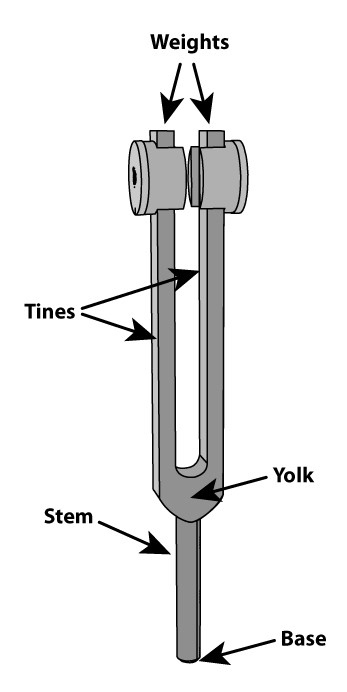
In the image to the above, we can see the yolk is a U-shaped section where the tines merge and transition into the stem. Weighted tuning forks have thinner tines than unweighted tuning forks, and the thin construction of the tines and addition of the weights focus the vibrations downward into the base instead of outward into the air. However, the story of vibration does not stop there.
The bigger story is told in the weight distribution of the tuning fork and the unbalanced physics dynamics across the entire length of the tuning fork. A weighted tuning fork is designed with an unbalanced fulcrum with the weights at the end of the tine forcing the vibrations down the tines, through the yolk, and into the stem. By placing the base of the tuning fork against the skin, we not only benefit from the downward travel of the vibrations created as the tines swing or oscillate back and forth, we also receive a much stronger effect of the stem vibrating in many directions just due to the physics of an unbalanced device.
Standard Striking Grip
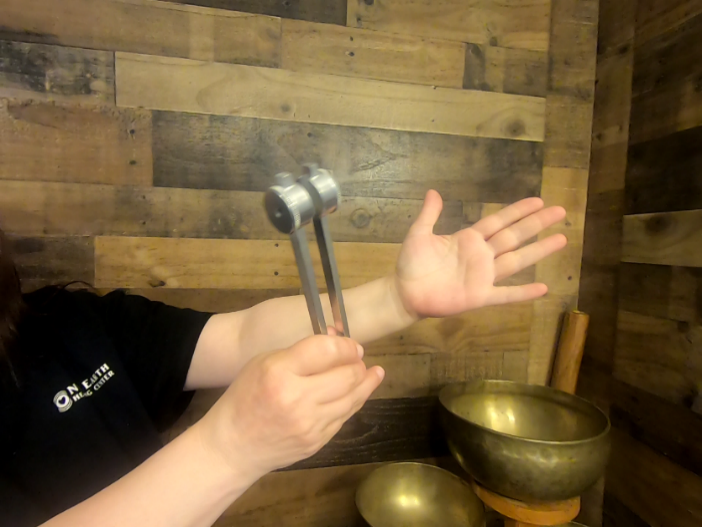
With a striking grip, we focus on holding the tuning fork for striking against a surface such as the hand or knee. Grips for striking are designed to prevent or reduce repetitive injury of the therapist while also providing a more effective grasping area on the yolk of the tuning fork instead of the stem where other practitioners tend to strike and hold the tuning fork.
Reverse Grip
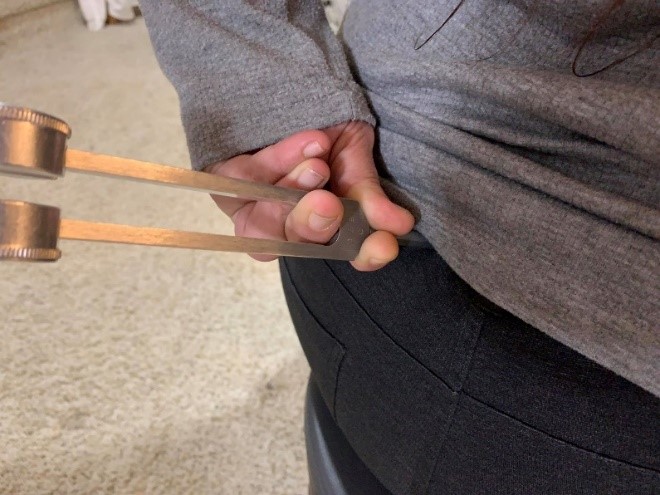
| Used for self-care, under chin, lymph nodes, sore throat, and hard to reach locations. |
Finger Assist Grip
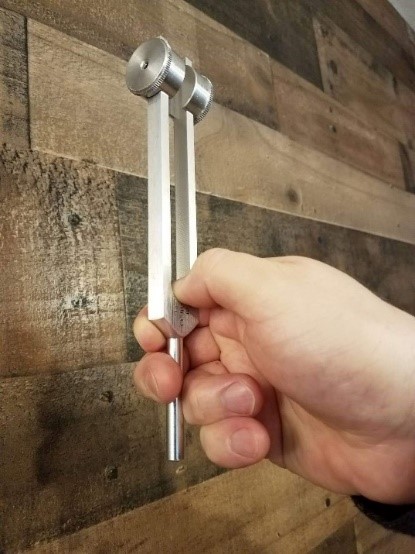
| Reduces hand fatigue and allows for use of sensing/palpation hand. Start by using the standard striking grip then transition over to finger assist grip after placing the tuning fork on the body. Use the thumb, index finger, or middle finger. Turn thumb sideways in the “U” shaped yolk if it does not fit flat. Vary your grip often to prevent fatigue. |
Butterfly Grip
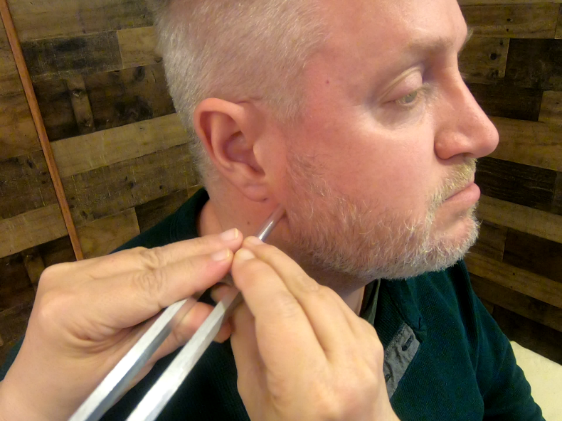
For max pressure with less grip. A butterfly grip will distribute your grip strength across both hands. Keep in mind that you do not need maximum pressure in every situation. Sometimes you might need to back off on the pressure you had with one hand when the second hand is added to the grip. The pressure more than doubles and could cause un-necessary pain in the client. This grip is designed to reduce repetitive stress, but it is used for increased pressure over a long time period like the lower back protocol. Do not use in areas where maximum pressure is not required in sensitive areas.
Strike Core Skill
The Strike Core Skill is important because the quality of a strike will affect the length and strength of the vibration for each placement. In vibrational fascia release, the release point for the cells and tissue might be at the trailing end of one specific strike that fell below the breakpoint.
Fascia collagen fibers and supporting cells require both pressure (stretch) and vibration to cause a change, and sometimes the change is the destruction (apoptosis) of the cells involved in the restriction or the release of the necessary substances to dissolve the collagen fibers responsible for the adhesion.
After our own testing and thousands of strikes, we believe that the best quality striking surface is our own body in two primary locations; the hand and knee. Body strike locations are efficient because we do not have to hold onto another object like an activator. Therefore, we can use the strike hand solely for sensing and feedback. A mastered Striking Core Skill should not hurt the therapist or leave marks. A properly executed strike has a distinct sound and feel. The key to a proper strike is the follow through of the hand holding the tuning fork. Focus a few inches beyond the point of impact so the hand continues to follow through after striking. With a proper follow-through, the weight of the tuning fork will “bounce” off the striking surface instead of controlling the exact moment of impact. In other words, it’s more of a bounce than a strike.
Hand Strike
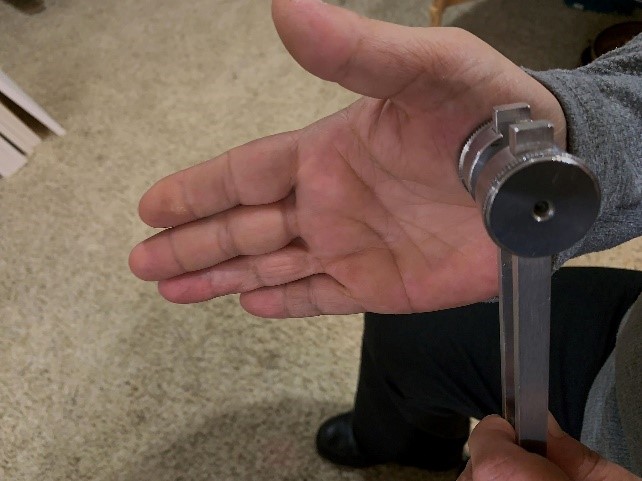
- Strike on the meaty part at the base of the palm
- Only the striking hand moves
- Strike the flat surface of the weight
- Aim for a spot beyond the striking surface
- Distinct “thump” sound
- A “tink” is okay, but a “ping” is too hard
Knee Strike
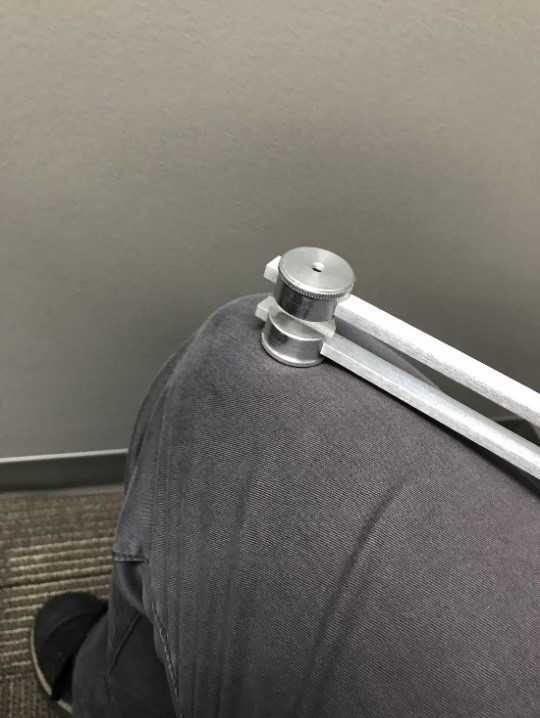
- Efficient in a sitting position
- Used when sensing hand marks a placement location
- Strike against meaty area closer to the inside of the leg where muscle is thicker
- Bend knee to tighten muscle on striking surface
- Avoid kneecap or bones
